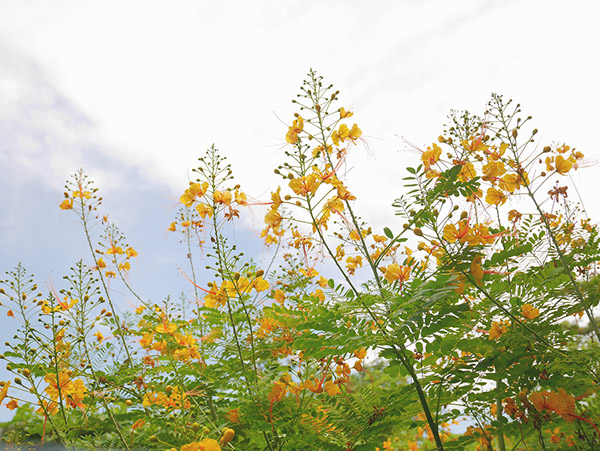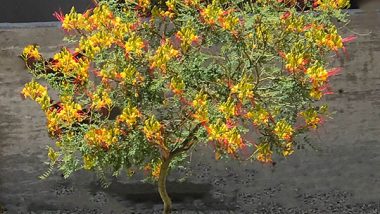Last updated on January 26th, 2025 at 11:34 am
The Mexican Bird of Paradise plant is known for its striking and vibrant flowers. The flowers typically have a yellow color with a yellow margin.
Furthermore, Caesalpinia mexicana is native to Mexico. Often known as Mexican Bird of Paradise, grows naturally in Mexico. Have you ever seen its bright yellow flowers? They truly stand out, don’t they? This plant thrives in warm climates and is a popular choice for gardeners looking to add a splash of color. Its ability to withstand heat makes it well-suited for arid environments. Does it fit your garden’s needs? Give it a try and see how it transforms your space. Form it into a small Patio tree
So, it would be perfect for a patio area for a small backyard. A very drought-tolerant and can tolerate freezing temperatures. It will be a challenging time growing when nighttime temperatures get below the mid-tee
The plant goes by numerous names poinciana, peacock flower, and the Yellow Bird of paradise. The Mexican Bird of Paradise Plant (Caesalpinia Mexicana). It has a distinct yellow flower and is considered a large shrub. Also, It’s easy to make it grow as a small tree.
Additionally, It can get up to 10-12 ft. tall sometimes taller and wider. It has flower clusters that are bright yellow, and fragrant and appear on the branches from spring until fall. It is a fast-growing large plant that is well suited for the hot desert sun.
Does it like full sun or shade?
It can also tolerate partial shade, placing it on the east or north side of your home would be ok. But it loves the full hot summer sun. Anything less the six hours of full sun and it will not bloom to its full potential. Unlike the Redbird of paradise, it will bloom only in early spring.
Like many plants, Caesalpinia mexicana contributes to the local ecosystem by providing habitat and food for various insects and birds.
Some species within the Caesalpinia genus contain compounds that can be toxic if ingested, so it’s important to exercise caution and avoid consumption. Read more about the Mexican Bird of Paradise plant over at Wikipedia
Understanding the water requirements of Caesalpinia Mexicana
Caesalpinia Mexicana is native to Mexico, where it grows in arid and semi-arid regions. In its natural habitat, it has adapted to survive in dry conditions by developing a deep root system that can access water from the ground. This means that the plant is well-suited to environments with low rainfall and limited water availability.
The soil type also plays a significant role in the water requirements of Caesalpinia Mexicana. The plant prefers well-draining soil that allows excess water to flow away. If the soil retains water, it can lead to waterlogged conditions that can cause root rot and other issues. Therefore, it’s crucial to ensure that the soil is well-drained and does not hold excessive moisture.
The climate is another important factor to consider when determining the water needs of Caesalpinia Mexicana. In regions with hot and dry climates, the plant will require more frequent watering to compensate for the high evaporation rates. On the other hand, in regions with cooler and more humid climates, the plant may require less water as the evaporation rates are lower.
Lastly, the stage of growth of Caesalpinia Mexicana also affects its water requirements. Newly planted or young plants will require more frequent watering to establish their root systems. As the plants mature, they become more drought-tolerant and require less water.
How to water Caesalpinia Mexicana effectively
To ensure the optimal growth and health of Caesalpinia Mexicana, it’s essential to water it effectively. Here are some tips on how to water this plant:
- Deep watering: Instead of frequent shallow watering, it’s best to provide a deep watering to Caesalpinia Mexicana. This means allowing the water to penetrate the soil thoroughly, reaching the root zone. Deep watering encourages deep root growth, making the plant more resilient to dry spells. It’s recommended to water until the soil is moist to a depth of at least 6 inches.
- Infrequent watering: Caesalpinia Mexicana is a drought-tolerant plant, so it doesn’t require excessive watering. It’s important to allow the soil to dry out between waterings. This prevents overwatering and ensures that the plant’s roots have access to oxygen. As a general rule, water the plant when the top inch of soil feels dry to the touch.
- Watering method: There are several methods you can use to water Caesalpinia Mexicana effectively. One common method is to use a soaker hose or drip irrigation system. These methods deliver water directly to the root zone, minimizing water loss through evaporation. Another option is to use a watering can or hose with a gentle spray nozzle, ensuring that the water is spread evenly over the soil surface.
Remember to water early in the morning or late in the evening when the temperatures are cooler. This reduces water loss through evaporation and allows the plant to absorb the water more effectively.
Signs of overwatering Caesalpinia Mexicana
Overwatering Caesalpinia Mexicana can have detrimental effects on its health. Here are some signs that indicate the plant is receiving too much water:
- Yellowing leaves: If the leaves of Caesalpinia Mexicana start turning yellow and falling off, it may be a sign of overwatering. Excessive moisture in the soil can cause the roots to rot, leading to nutrient deficiencies and leaf yellowing.
- Root rot: Overwatering can create waterlogged conditions in the soil, which can lead to root rot. If you notice a foul smell or mushy roots when inspecting the plant’s roots, it’s a clear sign of overwatering.
- Wilting and drooping: Surprisingly, overwatering can also cause wilting and drooping of the plant’s leaves. This is because the roots are unable to absorb oxygen properly in waterlogged conditions, leading to a lack of nutrients and moisture uptake.
If you notice any of these signs, it’s crucial to adjust your watering practices to prevent further damage to the plant.
Signs of underwatering Caesalpinia Mexicana
While Caesalpinia Mexicana is a drought-tolerant plant, it still requires adequate water to thrive. Here are some signs that indicate the plant is not receiving enough water:
- Wilting leaves: If the leaves of Caesalpinia Mexicana start to wilt and droop, it may be a sign of underwatering. The plant needs a sufficient water supply to maintain turgidity and keep the leaves upright.
- Dry soil: If the soil around the plant is dry and crumbly, it’s an indication that the plant is not receiving enough water. Check the moisture level in the soil by inserting your finger into the soil. If it feels dry to the touch, it’s time to water.
- Stunted growth: Underwatered plants may exhibit stunted growth, with shorter stems and smaller leaves. This is because the plant is conserving energy and resources due to the lack of water.
Best practices for watering Caesalpinia Mexicana in different seasons
The watering needs of Caesalpinia Mexicana can vary depending on the season. Here are some best practices for watering this plant in different seasons:
- Spring and summer: During the active growing season, Caesalpinia Mexicana may require more frequent watering. This is especially true in regions with hot and dry climates. Monitor the moisture level in the soil regularly and water when the top inch of soil feels dry. Provide deep watering to ensure the water reaches the root zone.
- Fall: As the temperatures start to cool down in the fall, the watering requirements of Caesalpinia Mexicana may decrease. However, it’s still important to monitor the soil moisture and water when necessary. The plant needs to store enough water to survive the winter months.
- Winter: Caesalpinia Mexicana is dormant during the winter, and its watering needs are minimal. If there is sufficient rainfall, you may not need to water the plant at all. However, if there is a prolonged period without rain, it’s important to provide some water to prevent the plant from drying out completely.
Remember to adjust your watering practices based on the specific conditions in your area. It’s always better to underwater than to overwater, as Caesalpinia Mexicana is more resilient to drought than excessive moisture.
Other factors to consider for optimal growth and health of Caesalpinia Mexicana
While water is essential for the growth and health of Caesalpinia Mexicana, there are other factors to consider as well. Here are some additional considerations:
- Sunlight: Caesalpinia Mexicana thrives in full sun, so it’s important to provide it with at least 6-8 hours of direct sunlight per day. Insufficient sunlight can lead to weak growth and fewer flowers.
- Soil fertility: Although Caesalpinia Mexicana is adaptable to a wide range of soil types, it performs best in well-drained soil with good fertility. Adding organic matter such as compost can improve soil structure and provide essential nutrients for the plant.
- Mulching: Applying a layer of organic mulch around the base of Caesalpinia Mexicana can help conserve soil moisture and suppress weed growth. Mulch also acts as an insulating layer, protecting the plant’s roots from extreme temperatures.
- Pruning: Regular pruning can help maintain the shape and size of Caesalpinia Mexicana. It’s best to prune the plant in late winter or early spring before new growth begins. Remove any dead or damaged branches to promote healthy growth.
By considering these factors and providing the right care, you can ensure the optimal growth and health of Caesalpinia Mexicana in your garden.
Common mistakes to avoid when watering Caesalpinia Mexicana
To ensure the success of your Caesalpinia Mexicana plants, it’s important to avoid some common watering mistakes. Here are a few mistakes to watch out for:
- Overwatering: As mentioned earlier, overwatering can lead to root rot and other issues. Avoid the temptation to water too frequently or provide excessive amounts of water. Instead, focus on deep watering and allowing the soil to dry out between waterings.
- Underwatering: While Caesalpinia Mexicana is drought-tolerant, it still requires regular watering to thrive. Avoid neglecting the plant and not providing enough water, especially during hot and dry periods. Monitor the soil moisture and adjust your watering practices accordingly.
- Inconsistent watering: Inconsistent watering can stress the plant and lead to uneven growth. It’s important to establish a regular watering schedule and stick to it. This will help the plant develop a consistent root system and promote healthy growth.
- Watering during the heat of the day: Watering during the hottest part of the day can lead to water loss through evaporation. It’s best to water early in the morning or late in the evening when the temperatures are cooler. This allows the plant to absorb the water more effectively.
By avoiding these common mistakes, you can ensure the health and longevity of your Caesalpinia Mexicana plants.
Conclusion and summary of water requirements for Caesalpinia Mexicana
Caesalpinia Mexicana, or Mexican Bird of Paradise, is a beautiful and vibrant plant that can add a touch of tropical beauty to your garden. Understanding its water requirements is crucial for its optimal growth and health.
Factors such as the plant’s natural habitat, soil type, climate, and stage of growth influence its water needs. It’s important to consider these factors when determining the watering practices for Caesalpinia Mexicana.
To water Caesalpinia Mexicana effectively, provide deep watering, ensure the water penetrates the soil thoroughly, and avoid frequent shallow watering. Monitor the soil moisture regularly and adjust your watering practices based on the specific conditions in your area.
By following these guidelines and avoiding common watering mistakes, you can ensure the optimal growth and health of Caesalpinia Mexicana in your garden. Enjoy the beauty this plant brings and create a stunning landscape that will be the envy of your neighbors.
USDA Zones 8-11
The Redbird of Paradise is another Caesalpinia that has red-orange flowers. Click here for more information

Greenhouse Manager, Master Gardener, and Webmaster.
If you have any questions or enjoyed this post, feel free to share your thoughts in the comments below.




Can I order plants to put in my garden? I love the Yellow Bird of Paradise Plant.
Sorry, Clista you will have to visit one of our stores to purchase them. They will be available about mid-spring 2022.
I live in N.W. Louisiana and have been growing these beautiful Mexican Bird of Paradise plants from seeds for many years. They thrive here.
This is great to know Robert. I am sure they do well in lots of humidity. Do you get lots of freezing temps during the winter seasons Robert? I was stationed at Ft. Polk a looong time ago.